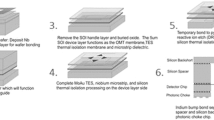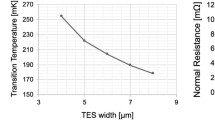Abstract
The Astrophysics 2020 Decadal Report recommended a line of Probe missions with far-infrared imaging or spectroscopy capabilities. The achievable sensitivity of these FIR missions will be enabled by cooled telescopes and advanced cryogenic detector technologies, potentially resulting in up to three orders of magnitude improvement in sensitivity and mapping speeds up to more than a million times of those achieved so far with past missions. We have obtained NASA funding to build and demonstrate transition edge sensor (TES)-based kilopixel arrays with the properties that match the requirements for cryogenic far-infrared space missions: The arrays are very closely tileable in one direction and with a moderate gap in the other direction. This array architecture can meet the sampling and pixel number requirement of a few 104 pixels. Many details of the architecture have already been demonstrated individually, and the detector board will be optimized for the use of the latest cryogenic NIST 2D time-domain SQUID readout multiplexers with a high-density fanout scheme. Additionally, we will use flex lines that are very similar to those developed at Princeton University for the ACT project. This method allows virtually unlimited tileability of the detector arrays and thus a compact detector/readout design for future FIR instrumentation requiring large pixel counts. We already have a pixel design which, if implemented with TES operating at less than 100 mK, will meet the continuum sensitivity requirements for background-limited cryogenic space missions of NEP < 10–18 W/√Hz). Furthermore, our array design will be compatible with lower noise TES designs for spectroscopy that we are currently demonstrating in our laboratory.





Similar content being viewed by others
References
Astro 2020: https://www.nationalacademies.org/our-work/decadal-survey-on-astronomy-and-astrophysics-2020-astro2020
Allen, C.A., Benford, D.J., Chervenak, J.A., Chuss, D.T., Staguhn, J.G., Miller, T.M., Moseley, S.H., Wollack, E.J., “Far Infrared Through Millimeter Backshort-Under-Grid Arrays,” 2006, Proceedings of the Society of Photo-Optical Instrumentation Engineers (SPIE), “Millimeter and Submillimeter Detectors and Instrumentation for Astronomy,” Editors J. Zmuidzinas, W.S. Holland and S. Withington, W.D. Duncan, Vol. III, p. B2750
D.A. Harper, M.C. Runyan, C.D. Dowell et al., The Far Infrared camera and polarimeter for SOFIA. J. Astron. Instr. 7(2), 1840008 (2018). https://doi.org/10.1142/S2251171718400081
Jhabvala, C.A., Benford, D., Brekosky, R., Chang, M.-P., Costen, N., Datesman, A., Hilton, G., Irwin, K., Kogut, A., Lazear, J., Leong, E., Miller, T., Moseley, S.H., Sharp, E., Staguhn, J., Weston, A., Wollack, E., “Kilopixel Backshort–Under–Grid Arrays for the Primordial Inflation Polarization Explorer,” 2014, Proc. SPIE, “Millimeter, Submillimeter, and Far-Infrared Detectors and Instrumentation for Astronomy VII,” Editors W.S. Holland and Jonas Zmuidzinas, Vol. 9153, p. 91533C, doi:https://doi.org/10.1117/12.2056995
E.R. Switzer, P.A.R. Ade, T. Baildon, D. Benford, C.L. Bennett, D.T. Chuss, R. Datta, J.R. Eimer, D.J. Fixsen, N.N. Gandilo, T.M. Essinger-Hileman, M. Halpern, G. Hilton, K. Irwin, C. Jhabvala, M. Kimball, A. Kogut, J. Lazear, L.N. Lowe, J.J. McMahon, T.M. Miller, P. Mirel, S.H. Moseley, S. Pawlyk, S. Rodriguez, E. Sharp, P. Shirron, J.G. Staguhn, D.F. Sullivan, P. Taraschi, C.E. Tucker, A. Walts, E.J. Wollack, Sub-Kelvin cooling for two kilopixel bolometer arrays in the PIPER resceiver. Rev. Sci. Instrum. 90, 095104 (2019). https://doi.org/10.1063/1.5108649
J.G. Staguhn, D.J. Benford, F. Pajot, Ames, T’. Allen, C.A., Chervenak, J.A., Lefranc, S., Maher, S., Moseley, S. H., Phillips, T., Rioux, C.G., Shafer, R.A., Voellmer, G.M., Proc. SPIE 5498, 438S (2004). https://doi.org/10.1117/12.552128
G.J. Stacey, S. Hailey-Dunsheath, T. Nikola, S.C. Parshley, D.J. Benford, S.H. Moseley, J.G. Staguhn, R.A. Shafer, Proc. SPIE 5498, 232S (2004). https://doi.org/10.1117/12.552013
T.A. Marriage, J.A. Chervenak, W.B. Doriese, NIMPA 559, 551M (2006). https://doi.org/10.1016/j.nima.2005.12.068
Staguhn, J.G. , Benford, D.J. , Fixsen, D.J., Hilton, G., Irwin, K.D., Jhabvala, C.A. , Kovacs, A., Leclercq, S., Maher, S.F. , Miller, T.M. , Moseley, S.H. , Sharp, E.H. , Wollack, E.J., 2012, Proc. SPIE, 8452E, 0TS, doi: https://doi.org/10.1117/12.927037
D.J. Benford et al., First astronomical use of multiplexed transition edge bolometers. Low Temp. Detect. 605, 589–592 (2002)
Staguhn, J., Brown, A., Duff3, S., Hilton, G., Sharp, E., Colazo, F., Costen, N., Moseley, S.H., Wang, F., Wollack, E., Yoon, S., 2022, Journal of Low Temperature Physics, vol. 209, issue 5–6, pp. 1180–1188;
J. Glenn, C.M. Bradford, E. Rosolowsky, R. Amini, K. Alatalo, L. Armus, A.J. Benson et al., Galaxy evolution probe. J. Astron. Telescopes Instr. Syst. (2021). https://doi.org/10.1117/1.JATIS.7.3.034004
E.M. Barrentine, K. Rostem, R.P. Brekosky, A.-D. Brown, F.A. Colazo, N.P. Costen, J.P. Hays-Wehle, W.-T. Hsieh, V. Kluengpho, A.S. Kutyrev, S.F. Maher, V. Mikula, T.M. Miller, J.B. Oxborrow, E.H. Sharp, T. Watanabe, E.J. Wollack, S.H. Moseley, Characterization of Si membrane TES bolometer arrays for the HIRMES instrument. J. Low Temp. Phys. (2018). https://doi.org/10.1007/s10909-018-1966-4
T. Suzuki, P. Khosropanah, M.L. Ridder, R.A. Hijmering, J.R. Gao, H. Akamatsu, L. Gottardi, J. van der Kuur, B.D. Jackson, Development of ultra-low-noise TES bolometer arrays. J. Low Temp. Phys. Low Temp. Phys. 184, 52–59 (2016)
Origins Space Telescope Technology Development Plan, 2019, https://asd.gsfc.nasa.gov/firs/docs/OriginsVolume2TechDevelopmentPlanREDACTED.pdf
Funding
Science Mission Directorate, 21-SAT21-0030, 21-SAT21-0030, 21-SAT21-0030, 21-SAT21-0030, 21-SAT21-0030, 21-SAT21-0030, 21-SAT21-0030, 21-SAT21-0030,21-SAT21-0030, 21-SAT21-0030, 21-SAT21-0030, 21-SAT21-0030, 21-SAT21-0030, 21-SAT21-0030, 21-SAT21-0030, 21-SAT21-0030, and 21-SAT21-0030.
Author information
Authors and Affiliations
Contributions
JS is PI of project and wrote the manuscript. E.S., A.B., A.D., M.D., and V.M. contributed figures. All authors are Co-Is on project. All have contributed technical support and/or technical advise to the project.
Corresponding author
Ethics declarations
Competing interests
The authors declare no competing interests.
Additional information
Publisher's Note
Springer Nature remains neutral with regard to jurisdictional claims in published maps and institutional affiliations.
Rights and permissions
Springer Nature or its licensor (e.g. a society or other partner) holds exclusive rights to this article under a publishing agreement with the author(s) or other rightsholder(s); author self-archiving of the accepted manuscript version of this article is solely governed by the terms of such publishing agreement and applicable law.
About this article
Cite this article
Staguhn, J., Sharp, E., Brown, A. et al. Design of Large Low Noise Transition Edge Sensor Arrays for Future FIR Space Missions. J Low Temp Phys (2024). https://doi.org/10.1007/s10909-024-03084-3
Received:
Accepted:
Published:
DOI: https://doi.org/10.1007/s10909-024-03084-3




